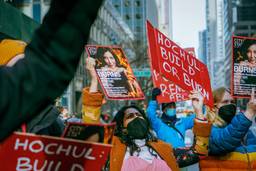A "Sustainable Square Mile" Tests the Power of Biden's Billions for Climate Justice
Can $3 billion in hyperlocal funding for environmental justice create lasting change?
Adam Mahoney
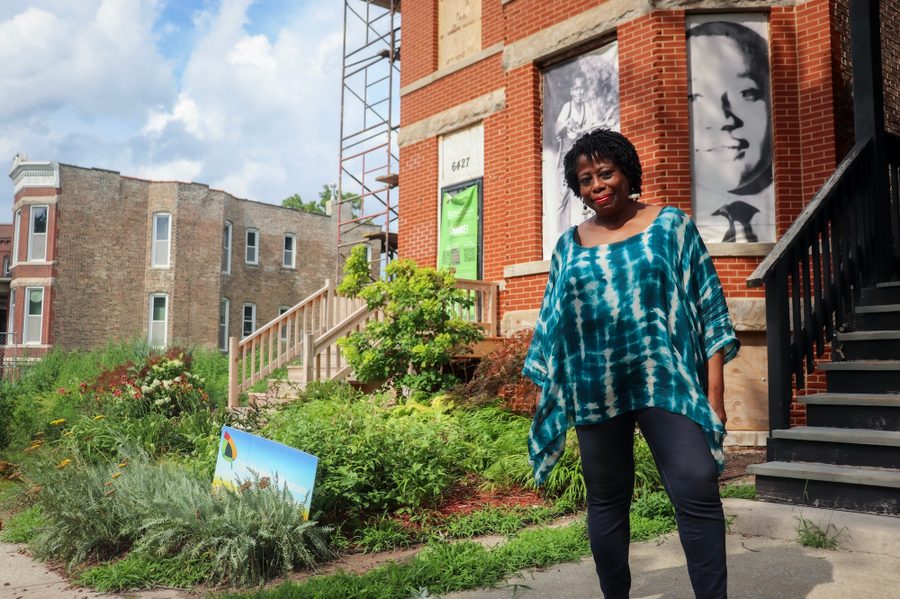
Two days after a series of tornadoes ripped through Chicago’s South Side, leaving hundreds of thousands of people without electricity, Naomi Davis and Suzanne Waddell met in the front yard of Emmett Till’s childhood home to assess the damage. Fencing had been blown down.
Their organization, Blacks in Green, founded by Davis in 2007, owns the historic landmark. It will open as a playhouse, community farm and museum in 2025, honoring the life the 14-year-old deserved to have. Even in 92-degree heat, people stopped by to take photos, a regular occurrence that reminds Davis of the larger duty marginalized people in America have “to remind each other of our greatness.”
For Davis, Till’s life also exemplifies the environmental racism her group has worked to expose. As a child, Till was diagnosed with polio, a debilitating disease that historically plagued the nation’s Black and immigrant communities and has everything to do with one’s environment, with the cleanliness of one’s water and food.
Till’s life, Davis explains, shows a “whole-system problem” that can only be transformed by a “whole-system solution.”
Till’s former home is the anchor of an ambitious plan for Blacks in Green to develop a “sustainable square mile” in the heart of a neighborhood the White House has deemed “disadvantaged” by nearly every metric. The group aims to equip the 90% Black community with all the trappings needed to survive those overlapping social harms as climate change intensifies, bringing with it more brutal weather (like this summer’s tornadoes and extreme heat), food scarcity and other challenges. The plan includes a solar and geothermal electric grid; farms and gardens to feed local households; affordable housing options for a neighborhood where three in 10 people live in poverty; climate resilience hubs where people can safely gather in times of severe weather; and job training in the clean energy and manufacturing industries to make sure people are not only putting food on the table, but doing it in a way that doesn’t reverberate harm back on the community.
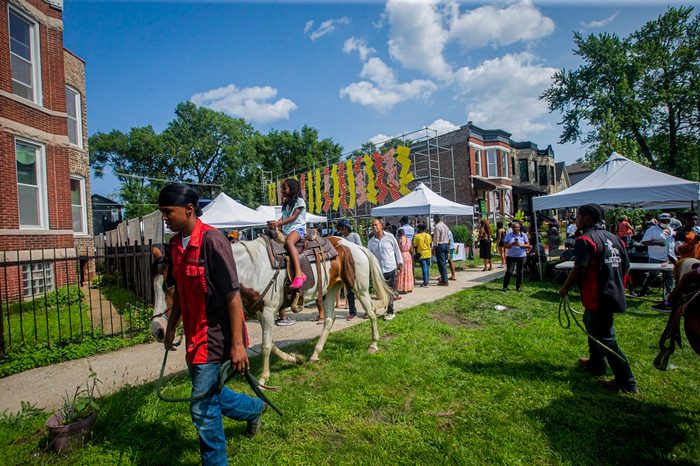
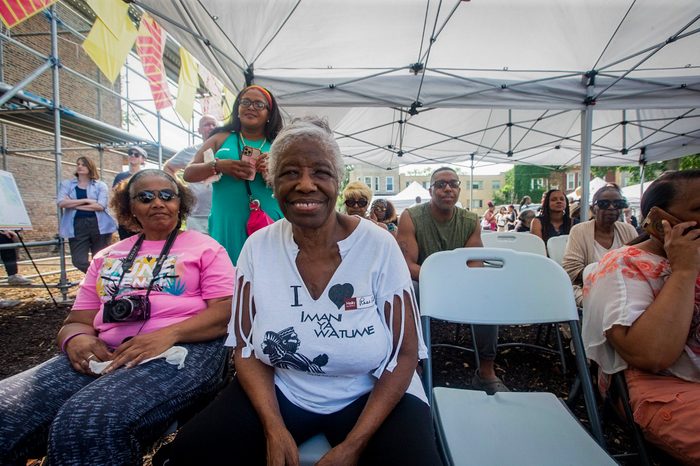
The group’s vision building environmental justice throughout Chicago and the greater Midwest is funded in part through $10 million from the Environmental Protection Agency (EPA) through the Biden administration’s Justice40 initiative. Created with a sweeping executive order during President Joe Biden’s first week in office, Justice40 is meant to ensure that communities deemed disadvantaged receive at least 40% of the benefits of federal climate change and environmental investments. Controversially, the program does not include race in its metrics for defining disadvantaged communities, despite race being the largest indicator of pollution exposure. Instead, it uses a set of environmental and economic indicators.
Justice40 guides the spending of more than a trillion dollars allocated through the Democrats’ main climate policies, the Inflation Reduction Act and the Bipartisan Infrastructure Law. Because Justice40 serves as a guideline, the federal government has a lot of leeway in what projects count. Building a facility for carbon dioxide removal (a controversial method) in Louisiana falls under Justice40, as does replacing lead water lines in Chicago.
There is no single tally of Justice40 spending or its benefits so far, although the White House Environmental Justice Scorecard says more than 500 projects have been funded, and it details many of them. “The fact that the program was oriented around quantifying ‘at least 40% of the overall benefits of investment’ rather than a more straightforward assessment of 40% of funding makes the program difficult to track and quantify,” says Chris Espinosa, the legislative director for the Climate and Energy Program at Earthjustice, an environmental law firm.
The EPA deferred comment to the White House Council on Environmental Quality, which did not respond to direct inquiries about the total amount of money spent through Justice40 or whether the 40% target was being met. Instead, Jalonne L. White-Newsome, White House environmental justice officer, explained that the “Justice40 Initiative is not a one-time investment, nor a single pot of money.” It is “transforming the way the federal government reaches communities.”
Espinosa agrees the approach “has merit,” saying the program’s emphasis on partnering with community-based organizations “is a very positive and welcome change.”
Most federal climate grants are accessible only to municipalities or corporations; the most unprecedented aspect of Justice40 has been the allocation of $3 billion in grant money for community-based nonprofits like Blacks in Green, including $200 million in technical assistance to help groups apply. Theoretically, this process cuts out much of the bureaucracy that has defined federal grant-making and allows those who know the problems to directly address their community’s unique challenges, fostering tangible, immediate improvements. In practice, concerns about how quickly funding and resources are actually reaching local organizations remain — particularly as the future of the program is rocky.
In all, since 2023, the Biden administration has awarded some $368 million directly to community-based nonprofits out of the $3 billion pot, with many of the projects not yet underway or in early stages. Instead — as the vast majority of climate-related grants still flow through statehouses — corporate lobbyists and conservative lawmakers have the ability to thwart the process of Justice40.
“It is always exciting to not have to fight against the government to focus on resourcing [environmental justice] communities,” says Marisa Sotolongo, senior policy analyst with the Initiative for Energy Justice. But, she says, there is still “a lack of decision-making and autonomy that communities are feeling even though they’re supposed to be kind of the center of the engagement of this Justice40 Initiative.” As climate change makes environmental degradation inescapable, Justice40 may prove mitigation efforts are more effectively crafted in a community center than Congress.
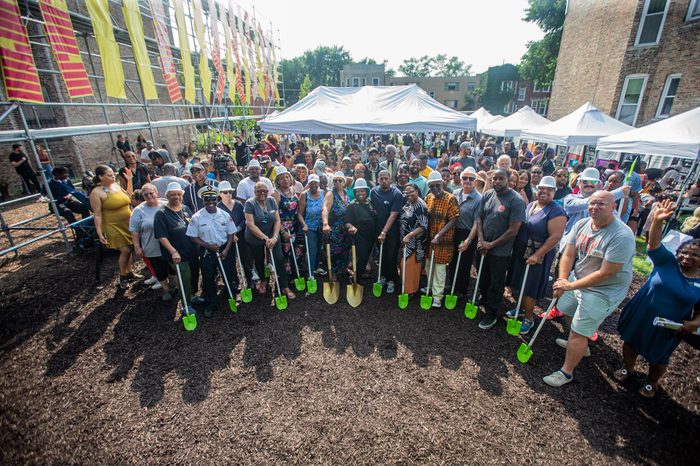
Environmental justice advocates warn that, without a justice framework shaping all of the federal government’s climate spending, the impact of Justice40 can only go so far.
Rhiana Gunn-Wright, an original architect of the Green New Deal, notes that much of the funding earmarked in the Inflation Reduction Act, such as homeowner tax credits for green upgrades, “disproportionately serves the needs and interests of middle-class white people.” Gunn-Wright’s vision of a Green New Deal, parts of which were later introduced at the federal level by Rep. Alexandria Ocasio-Cortez and Sen. Edward Markey, centered on ensuring a gradual shift of decision-making about federal resources to the hyperlocal level, so communities could combat the climate crisis in ways that specifically address the “contours of their lives.” She argues that Justice40 could help power this shift — if the direct grants to community organizations like Blacks in Green were vastly expanded.
“When it comes to race, especially in climate justice, we should be planning for the worst and hoping for the best,” she says. “Instead, we do the opposite: We plan for the best. But what do you expect to happen when you release a lot of money into an unjust system?”
A 2023 policy analysis in the journal Science provides one indication. Scientists modeled the three most likely outcomes of the Democrats’ climate investments and found that pollution exposure will decrease at a faster rate for white communities than communities of color. Ironically, that outcome suggests the racial gap in pollution exposure may actually grow.
Additionally, as green infrastructure investment has skyrocketed in communities of color, so has spending on highways and manufacturing facilities that are land-, energy- and water-intensive, all of which may add to the pollution burden—sometimes under the auspices of Justice40.
These realities — coupled with recent Supreme Court rulings defanging the EPA and the threat of right-wing policy proposals like Project 2025 calling to “stop all grants to [environmental] advocacy groups” — endanger a true reparative legacy of Justice40, regardless of who is in office next year.
Davis sees the history of the Civil Rights Movement as a cautionary tale: “We saw people being castrated, hung and run out of town through a campaign of terror, and we took a stand and gained movement status. Then, over five decades and trillions of dollars, we now look at the metrics of our health and wealth and we see that we’re at the bottom of the barrel.” But history doesn’t have to repeat itself, Davis believes.
Combating the climate crisis will require coupling billions in federal dollars with work at the block-by-block level to remind communities of their true power once again. The most compelling hope comes from groups like Blacks in Green, who have already received money to build a scaffolding that will allow groups to flourish if and when the program — and attention on environmental justice — runs dry.
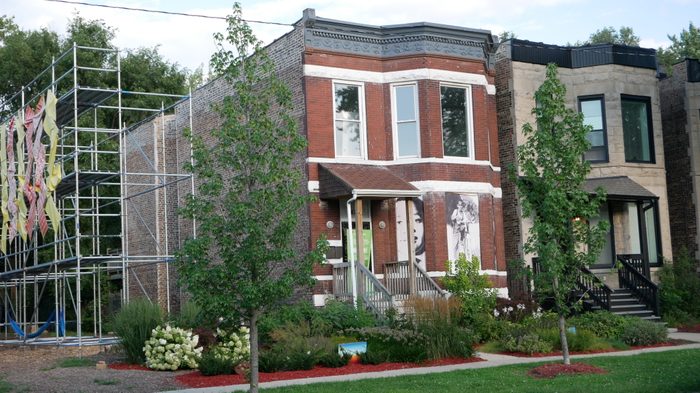
As Waddell and Davis drove through the square-mile block bounded by Cottage Grove Avenue and the infamous Parkway Gardens, a public housing complex that birthed the likes of Michelle Obama and Chief Keef, it was obvious they were fixtures of the community. They stopped to talk to residents like J.J., a man trying to fix up his childhood home first purchased by his grandma decades ago, and they offered support to a woman whose car had just broken down. (A group of Venezuelan migrants, who sometimes sit in the neighborhood looking for support, were already on it.)
Building these kinds of relationships is the only way to make the work work, Davis says. “This work is about helping our community to understand itself again as its own emergency management system, as its own network.”
So far, the group has procured roughly a dozen parcels of neighborhood land on which to build gardens, a green walking trail and affordable homesteads owned and occupied by families making 30%, 60% and 80% of the area’s median income. The homesteads would allow tenants to “produce their own energy, grow their own food, clean their own water and recycle their own waste.”
That grand vision is still in its early stages. Currently, Blacks in Green runs community programs that have helped neighbors remove lead pipes in their homes, install climate-friendly heat pumps and participate in regular discussions on how to limit their energy use. Earlier this year, the group purchased a defunct church to convert into a space for emergency heating and cooling, energy industry education and a “sanctuary for youth.”
In addition to the federal government, the group has developed logistical and financial partnerships with the Environmental Defense Fund, National Resources Defense Council, and others. Through the EPA, Blacks in Green has been named a “technical assistance hub” helping smaller groups without robust grant-writing operations access federal funds through Justice40.
Earthjustice’s Chris Espinosa warns that “more technical assistance and infrastructure must be built up to support smaller entities that often don’t have the capacity needed to apply for and manage complex federal grants.”
And even as challenges in access remain for small community groups, Davis says the lure of what she calls the “Biden billions” entices applicants without real roots in environmental justice or in community needs. “There are a lot of people participating in environmental justice work who don’t understand the history of it, have never suffered any of the impacts of it, don’t understand the principles around it and have no skin in the game,” she says.
The Biden billions also create a danger of dependency on grants and the federal government for groups to function. “There’s been a lot of investment, and there will be more coming down, but it’s a cumbersome process with challenges for smaller organizations, and we’ll see how that will play out under a different administration,” says Wendy Tarr, executive director of Vincentian Ohio Action Network, which was selected to receive $500,000 through Justice40 in January. The group plans to train 40 incarcerated people in solar installation through a hands-on program in Ohio’s prisons. In the case that Justice40 ceases to exist in a few years, the group has also created safeguards, admitting several people to the program who are serving life sentences, who can continue to share the training and knowledge inside down the road.
Davis is blunt about the realities of depending on a historically harmful power structure to now become your liberator: You can’t. That’s why, she says, the goal for Justice40 — and all of the programs that purport to advance environmental justice — is to use these resources to build your own sustainable ecosystems.
“We’re in a moment where millions are flowing, but it won’t last forever,” Davis says. “We have to make sure we do.”
Adam Mahoney is the climate and environment reporter at Capital B who has reported from more than a dozen U.S. states, Palestine, Mexico, Uganda and Vietnam.






